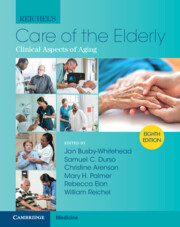Book contents
- Reichel’s Care of the Elderly
- Reichel’s Care of the Elderly
- Copyright page
- In Memoriam
- Contents
- Contributors
- Section I General Approach to the Care of the Elderly
- Section II Geriatric Syndromes
- Section III Care of the Elderly by Organ System
- Section IV Principles of Care for the Elderly
- Chapter 46 Surgical Principles
- Chapter 47 Rehabilitation
- Chapter 48 Geriatric Sexuality
- Chapter 49 Aging in Adults with Intellectual Disabilities and Severe and Persistent Mental Illness
- Chapter 50 Home- and Community-Based Long-Term Care
- Chapter 51 Institutional Post-Acute and Long-Term Care Medicine
- Chapter 52 Hospital-Based Care
- Chapter 53 Introduction to Palliative Care
- Chapter 54 The Mistreatment of Older Adults
- Chapter 55 Driving and the Older Adult
- Chapter 56 Integrative Medicine
- Chapter 57 Retirement
- Chapter 58 Cultural Competence
- Chapter 59 Health Literacy
- Chapter 60 Caregiving
- Chapter 61 Practice Transformation for Better Care of Older Adults
- Chapter 62 Health-Care Organization and Financing
- Chapter 63 Ethical Decision-Making
- Chapter 64 Epidemic and Pandemic Impacts on the Elderly Population
- Index
- Plate Section (PDF Only)
- References
Chapter 55 - Driving and the Older Adult
from Section IV - Principles of Care for the Elderly
Published online by Cambridge University Press: 30 June 2022
- Reichel’s Care of the Elderly
- Reichel’s Care of the Elderly
- Copyright page
- In Memoriam
- Contents
- Contributors
- Section I General Approach to the Care of the Elderly
- Section II Geriatric Syndromes
- Section III Care of the Elderly by Organ System
- Section IV Principles of Care for the Elderly
- Chapter 46 Surgical Principles
- Chapter 47 Rehabilitation
- Chapter 48 Geriatric Sexuality
- Chapter 49 Aging in Adults with Intellectual Disabilities and Severe and Persistent Mental Illness
- Chapter 50 Home- and Community-Based Long-Term Care
- Chapter 51 Institutional Post-Acute and Long-Term Care Medicine
- Chapter 52 Hospital-Based Care
- Chapter 53 Introduction to Palliative Care
- Chapter 54 The Mistreatment of Older Adults
- Chapter 55 Driving and the Older Adult
- Chapter 56 Integrative Medicine
- Chapter 57 Retirement
- Chapter 58 Cultural Competence
- Chapter 59 Health Literacy
- Chapter 60 Caregiving
- Chapter 61 Practice Transformation for Better Care of Older Adults
- Chapter 62 Health-Care Organization and Financing
- Chapter 63 Ethical Decision-Making
- Chapter 64 Epidemic and Pandemic Impacts on the Elderly Population
- Index
- Plate Section (PDF Only)
- References
Summary
Driving is an essential and highly valued instrumental activity of daily living that becomes increasingly difficult to safely maintain with age-related medical conditions. Health-care providers are uniquely positioned to (1) identify and modify risk factors associated with on-road safety, (2) offer rehabilitation strategies to improve safety and extend driving life, and (3) combine clinical information with resources related to driving to support safe continued community for older patients. Clinicians face myriad challenges in assessing patients' medical fitness to drive, including multiple comorbidities, polypharmacy, and reluctance to address driving issues due to the potential impact on the relationship with the patient, as well as legal/ethical concerns. However, assessment and intervention are important to prevent injury and the potential loss of driving privileges, the latter which may have a negative impact on quality of life. This chapter describes the functional abilities necessary to be a safe driver at any age; acute and chronic medical risk factors for driving impairment; clinical tools to stratify risk of medical impairment to drive; opportunities to intervene or refer patients flagged for impairments; resources to support patients transitioning from driver to nondriver; and ethical and legal concerns for clinicians advising patients on driving.
- Type
- Chapter
- Information
- Reichel's Care of the ElderlyClinical Aspects of Aging, pp. 675 - 683Publisher: Cambridge University PressPrint publication year: 2022

